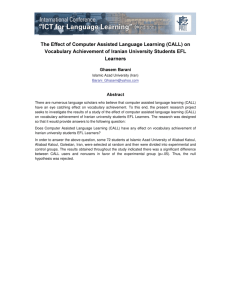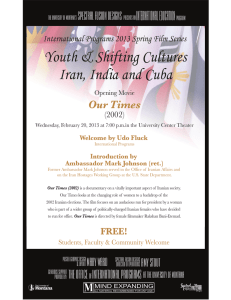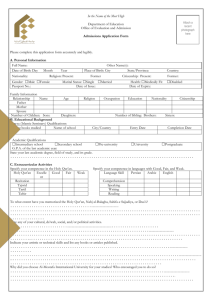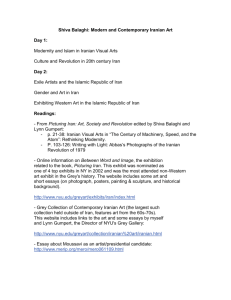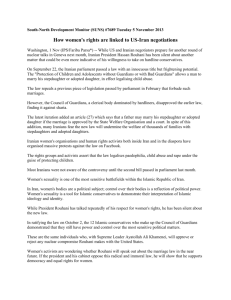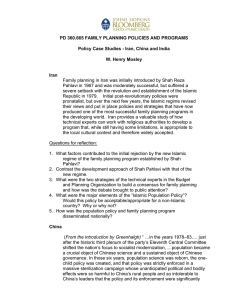6 The RAND Corporation is a nonprofit from
advertisement
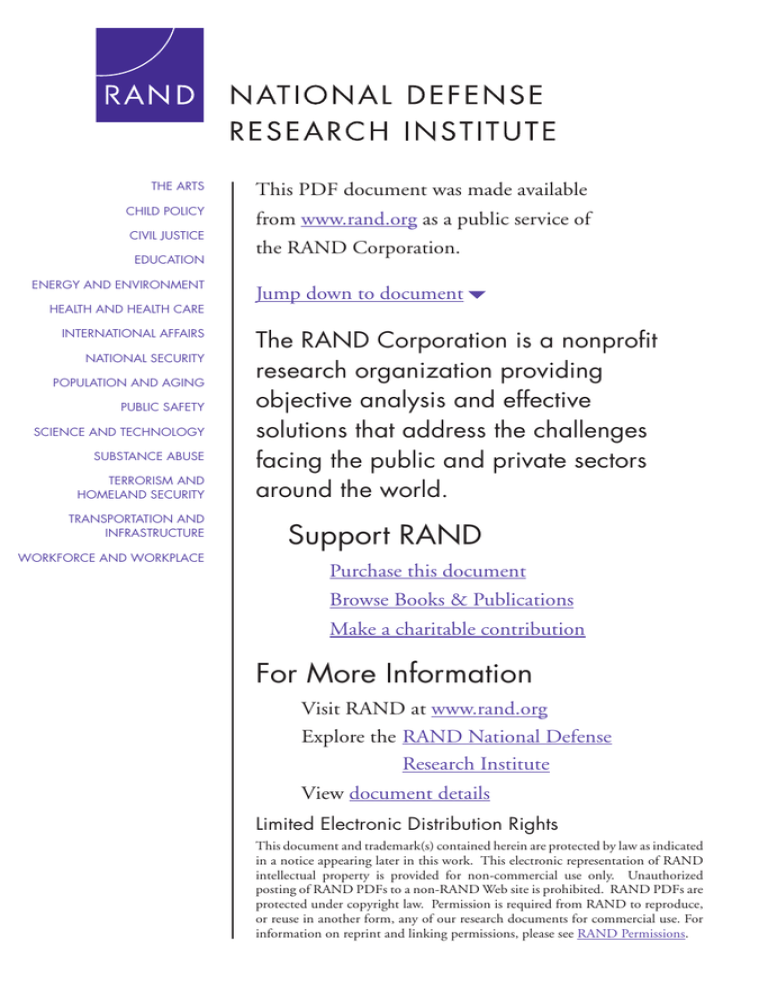
THE ARTS This PDF document was made available CHILD POLICY from www.rand.org as a public service of CIVIL JUSTICE EDUCATION ENERGY AND ENVIRONMENT HEALTH AND HEALTH CARE INTERNATIONAL AFFAIRS NATIONAL SECURITY POPULATION AND AGING PUBLIC SAFETY SCIENCE AND TECHNOLOGY SUBSTANCE ABUSE TERRORISM AND HOMELAND SECURITY TRANSPORTATION AND INFRASTRUCTURE WORKFORCE AND WORKPLACE the RAND Corporation. Jump down to document6 The RAND Corporation is a nonprofit research organization providing objective analysis and effective solutions that address the challenges facing the public and private sectors around the world. Support RAND Purchase this document Browse Books & Publications Make a charitable contribution For More Information Visit RAND at www.rand.org Explore theRAND National Defense Research Institute View document details Limited Electronic Distribution Rights This document and trademark(s) contained herein are protected by law as indicated in a notice appearing later in this work. This electronic representation of RAND intellectual property is provided for non-commercial use only. Unauthorized posting of RAND PDFs to a non-RAND Web site is prohibited. RAND PDFs are protected under copyright law. Permission is required from RAND to reproduce, or reuse in another form, any of our research documents for commercial use. For information on reprint and linking permissions, please see RAND Permissions. This product is part of the RAND Corporation monograph series. RAND monographs present major research findings that address the challenges facing the public and private sectors. All RAND monographs undergo rigorous peer review to ensure high standards for research quality and objectivity. Mullahs, Guards, and Bonyads An Exploration of Iranian Leadership Dynamics David E. Thaler, Alireza Nader, Shahram Chubin, Jerrold D. Green, Charlotte Lynch, Frederic Wehrey Prepared for the Office of the Secretary of Defense Approved for public release; distribution unlimited NATIONAL DEFENSE RESEARCH INSTITUTE The research described in this report was prepared for the Office of the Secretary of Defense (OSD). The research was conducted in the RAND National Defense Research Institute, a federally funded research and development center sponsored by the OSD, the Joint Staff, the Unified Combatant Commands, the Department of the Navy, the Marine Corps, the defense agencies, and the defense Intelligence Community under Contract W74V8H-06-C-0002. Library of Congress Cataloging-in-Publication Data is available for this publication. ISBN 978-0-8330-4773-1 The RAND Corporation is a nonprofit research organization providing objective analysis and effective solutions that address the challenges facing the public and private sectors around the world. RAND’s publications do not necessarily reflect the opinions of its research clients and sponsors. R® is a registered trademark. Cover image courtesy of Associated Press. © Copyright 2010 RAND Corporation Permission is given to duplicate this document for personal use only, as long as it is unaltered and complete. Copies may not be duplicated for commercial purposes. Unauthorized posting of RAND documents to a non-RAND Web site is prohibited. RAND documents are protected under copyright law. For information on reprint and linking permissions, please visit the RAND permissions page (http://www.rand.org/publications/permissions.html). Published 2010 by the RAND Corporation 1776 Main Street, P.O. Box 2138, Santa Monica, CA 90407-2138 1200 South Hayes Street, Arlington, VA 22202-5050 4570 Fifth Avenue, Suite 600, Pittsburgh, PA 15213-2665 RAND URL: http://www.rand.org To order RAND documents or to obtain additional information, contact Distribution Services: Telephone: (310) 451-7002; Fax: (310) 451-6915; Email: order@rand.org Summary The Islamic Republic of Iran is now perceived by many as a rising power in the Middle East and a long-term challenge to U.S. regional interests. The fall of Iran’s archenemy, Saddam Hussein, has enabled it to expand its influence in Iraq and beyond. Its nuclear program continues relatively unabated, with the Islamic Republic defying international condemnation and sanction to pursue an ostensibly civilian nuclear program—a program that could, technically, provide Tehran with a “breakout” capacity for nuclear arms, if it is not already a cover for a dedicated military effort. President Mahmoud Ahmadinejad has fueled the fire through his inflammatory rhetoric about the United States, its allies in the Persian Gulf region, and Israel and through his systematic denial of the Holocaust. And the presidential election in June 2009—after which the government’s quick declaration of a landslide Ahmadinejad victory was challenged as fraudulent by reformist candidate Mir Hossein Mousavi and a wide array of opposition groups endured a government crackdown—presents yet another cause for U.S. and Western concern. Yet the U.S. ability to gauge the extent and totality of the challenges posed by Iran is handicapped by the lack of official relations between the two states since 1980. Moreover, observers of the Iranian regime, both within Iran and abroad, often lament the opacity of Iranian decisionmaking processes, which presents serious impediments not only to those observers trying to understand the Iranian system and the policies it produces but even to average Iranians themselves. U.S. policymakers need both a more complete picture of the driving characteristics of the Iranian regime than they currently have and a frame- xi xii Mullahs, Guards, and Bonyads work to appropriately interpret Tehran’s words and actions and formulate effective policies for securing U.S. interests vis-à-vis the Islamic Republic. The objective of this book is to offer a framework to help U.S. policymakers and analysts better understand existing and evolving leadership dynamics driving Iranian decisionmaking. The research herein provides not only a basic primer on the structure, institutions, and personalities of the Iranian government and other influential power centers but also a better understanding of the strategic culture underlying Iranian policy formulation and execution. Our overall goal is to provide insight into the character of the Iranian system, not to detail the pieces and interrelationships themselves. Iranian Strategic Culture: Views of Itself and the World The elite of the Islamic Republic of Iran perceive Iran as the natural, indispensable, and leading power of the Middle East, even of the Muslim world. Iran’s perception of its own unique centrality is informed by a strong sense of Iranian identity and by its awareness of its role as one of the region’s historical powers. Iran’s sense of pride and importance is influenced by feelings of victimization, insecurity, and inferiority arising from historical exploitation by outside powers. The Iranian view of the United States as the successor to British imperial rule was shaped by the 1953 Anglo-American coup that ousted Prime Minister Mohammad Mossadegh and returned Mohammad Reza Shah Pahlavi to power. This perception is still an important factor in shaping and driving Iran’s strategic culture and worldview. The Islamic Republic now views the United States as its main adversary and as a threat to the regime’s survival. Iran’s perception of itself is shaped by a long history of victory and defeat; it sees itself as a once-great power humbled and humiliated by the West, particularly the United States. The Islamic Revolution enhanced Iran’s sense of exceptionalism and created a potent mixture of religious ideology and deep-seated nationalism. The Islamic Republic today has the ability to act beyond the confines of the revolution as Summary xiii a nation pursuing nonideological state interests, but its viewpoints and behavior continue to be shaped by the country’s tortured history and identity as a revisionist and revolutionary state. Key Observations on How the Iranian Political System Works The Iranian system is one in which the informal trumps the formal, power and influence derive as much (if not more) from personality as from position, and domestic factional dynamics drive policy debates and policymaking. The system is much more than just the institutions authorized in the country’s constitution. A peculiarly Iranian style of checks and balances—one that is undergoing change in the aftermath of the 2009 election—ensures that no one faction becomes so dominant as to challenge the Supreme Leader, Khamenei. There are purposeful bifurcations between the elected and the unelected and between the formal and the informal. The Supreme Leader traditionally has stood as a powerful arbiter over competing power centers, ensuring his stature by demonstrating his apparent aloofness from the fray yet entering that fray when required. However, Khamenei’s decisive declaration of support for Ahmadinejad after the 2009 election has irreparably harmed Khamenei’s position as an arbiter and may have significantly decreased his credibility among Iran’s diverse power centers. The System: Personalities, Informal Networks, Institutions The system is a composite of key personalities, their informal networks and relationships with other individuals and power centers, and the institutions with which these personalities are associated. A number of key individuals (including, first and foremost, Khamenei) have dominated the political elite in Iran, largely since the 1979 revolution and certainly since the death of the father of the revolution, Ayatollah Ruhollah Khomeini, a decade later. These personalities draw on multiple networks of various commonalities—interleaved family, experiential, clerical, political, financial, and other relationships and interests—that serve as levers of patronage, mobilization, and dissent. xiv Mullahs, Guards, and Bonyads Lastly, individuals use their positions in institutions to acquire financial wealth and to become sources of patronage, thereby empowering their own families, allies, and networks. The more powerful, influential, and well-connected the individual or individuals leading an institution are, the greater the weight that institution gains in policymaking and implementation within Iran. In sum, it is the combination of key personalities, networks based on a number of commonalities, and institutions—not any one of these elements alone—that defines the political system of the Islamic Republic. The Supreme Leader Retains the Most Power, but He Is Not Omnipotent Khamenei is the most powerful and influential individual in Iran. His power derives from a number of sources, including his own broad networks of representatives, appointees, and confidantes; his role as commander in chief; and his very position as Supreme Leader. But, lacking Khomeini’s iconic status and charisma, Khamenei must balance a multitude of competing interests to ensure that no single faction or group becomes so dominant that it threatens his power and prerogatives. This means operating in what is a relatively dysfunctional political system that tends toward stasis and where the absence of forward movement and innovation in the system is normal. “Balance” among interest groups is the guarantor of the Supreme Leader’s indispensability. However, recently, he acts less like an even-handed arbiter and more like a participant in the rivalries among individuals, groups, and factions. He shows a preference for ideological and social conservatives, considering them authentic revolutionaries and his natural allies. He welcomes “resistance” against the United States and the West as long as the risks of confrontation are contained. Factional Competition Drives Political Discourse and Policymaking The Supreme Leader encourages factional rivalry as long as it does not threaten the system. The factions in turn operate within the limits needed to preserve the Islamic regime, but survival of the regime is the point at which the so-called consensus ends. Factional maneuvering is a key manifestation of the competition for power and influence, and Summary xv foreign- and domestic-policy issues are used as tools and are extensions of this competition. Factions use foreign policy to promote their domestic agendas. For example, Mohammad Khatami and the reformists pursued normalization and a “dialogue of civilizations” to open Iranian society, and Ahmadinejad and his factional allies have pursued confrontation as an excuse to restrict it. Factional differences over foreign and domestic policies are, at their core, an ongoing battle between fundamentally different views of what Iran should become. This battle engenders a debate about the essence of the state and the legitimacy and staying power of the Islamic Revolution. Contention between the two visions—one emphasizing the Islamic Revolution and a model of resistance and self-sufficiency, the other emphasizing the Islamic Republic and a model of normalcy and independent development—will endure for years to come. At the time of writing in summer 2009, the revolutionary mind-set appeared to be ascendant. Iran’s Domestic Power Politics Are Highly Dynamic and Periodic In each of the three decades since the revolution, a different power center has been more influential than others. During the Khomeini era and the Iran-Iraq War, the clerics appeared to enjoy a period of primacy. The 1990s were the era of economic dominance of the bonyads (parastatal foundations), with the clerics continuing to wield considerable political influence. The Islamic Revolutionary Guard Corps (IRGC) appears to have dominated during the first decade of the millennium, using Iran’s increased emphasis on security issues as a political and economic lever. A new generation of lay leaders with an IRGC pedigree—Ahmadinejad, Ali Larijani, Mohammad Baqer Qalibaf, and others—has arisen to pose a challenge to clerics and to the “old guard.” In the 1980s and 1990s, the most-valuable connections were ties with the clerics, but now they are ties with the Revolutionary Guards. The IRGC and the Basij increasingly insert themselves into politics and business. However, as with any power center in Iran, the IRGC is not monolithic. Senior commanders appointed by the Supreme Leader may be revolutionary “fire-breathers,” but others among the rank-and-file (including those who fought in the Iran-Iraq War) may be more repre- xvi Mullahs, Guards, and Bonyads sentative of the larger society of Iran, with many of the latter espousing a more pragmatic view of the world. Emerging Trends to Watch in Iran Our research identified three trends that appear to be emerging as key determinants of the future direction of the Islamic Republic of Iran. The Revolutionary Guards: Will They Rise or Fall? As the third decade of the Islamic Revolution comes to a close, the future role of the IRGC arises as a key question. The Guards appear to have played a major role in ensuring an Ahmadinejad victory in the June 2009 presidential election. The IRGC is a major domestic political, economic, and security power center, and active members and alumni pervade the government and other sectors of society. A spectrum of mind-sets has emerged within the IRGC vis-à-vis the environment in which the organization operates. One view is more security-conscious, with holders of this mind-set seeing the existence of a geostrategic battle between Iran and the United States for power and influence in the region and wanting to pursue confrontation to secure the “rights” of Iran and the survival of the Islamic Revolution. Others in the IRGC are more profit-oriented and are focused on securing lucrative business ventures. Although they agree that Iran is engaged in a strategic competition with the United States, they believe that the rivalry between the two countries can be eased in the name of a more positive commercial environment. What future might evolve from this situation? If the Guards continue to gain political power, they could begin to see themselves as kingmakers and demand more from the Supreme Leader and the clerics. Or, the IRGC may—especially if it is at the apex of its domestic influence when Khamenei dies—make a bid for power in the next several years, possibly even challenging the Assembly of Experts in selecting the next Supreme Leader. This second scenario could be quite worrisome if the Islamic Republic were to attain the capacity to build and deploy nuclear weapons. Alternatively, an increase in the IRGC’s focus Summary xvii on economic power could lead it to become an institution that is profit driven, bureaucratic, less flexible, and more risk averse. A focus on business and profits could cause the IRGC to see greater utility in regional stability and reduced tensions with the United States and the West. The Old Guard: Vulnerable to Challenge? A second trend to watch over the next few years is the evolution of the relationship between the older generation, which overthrew the Shah and brought Khomeini to power, and a younger cohort of lay leaders (with some clerical allies) who were shaped primarily by the early years of the Islamic Republic and are less beholden to the older establishment. The leaders of the older generation are entrenched politically and financially and do not retire voluntarily from politics. Yet, as gatekeepers, they have been instrumental in admitting the younger generation into the governing elite. The new generation of “revolutionary” leaders is seeking to carve out independent centers of power and influence, sometimes in ways that may challenge the positions and power of their elders. Ahmadinejad’s populist outreach to the rural and urban underclasses and his public accusations against “economic mafias” can be partially understood in this context. At some point in the future, the older generation will pass naturally from the scene. The question is whether its members will be forced out before that time and, if so, what this might mean for the Iranian system. Clearly, the Islamic Republic’s traditional elites have survived past internal challenges by remaining unified when under threat and by adapting to or co-opting countervailing political and social trends. The Next Supreme Leader: Who or What Will Succeed Khamenei? By 2009, Khamenei will have held the position of Supreme Leader for two-thirds of the Islamic Republic’s existence. He will have guided Iran through periods of tension and momentous change in its neighborhood and through international condemnation and isolation over its nuclear program. But he turned 70 years old in 2009, and rumors about his deteriorating health have recently surfaced. The nature of the succession when he passes from the scene will be difficult to predict. Will the transition be smooth, or will it be marked by conflict that xviii Mullahs, Guards, and Bonyads destabilizes the system? What kind of successor will be selected, and how might the office of Supreme Leader evolve? The next Supreme Leader will be a primary determinant of how the other two trends evolve. The scope of his power and the level of his influence within the system will be critical factors in determining Iran’s future direction, particularly with regard to relations with the United States and with other states in the region. A relatively strong leader may continue the status quo or steer the country toward gradual change (for ill or good, depending on one’s perspective), whereas a weak leader could be exploited or dominated by other power centers, such as the IRGC. In the latter case, the very nature of the Islamic Republic could change drastically and in potentially destabilizing ways. In our view, therefore, the internal discussions and activities surrounding the succession of the Supreme Leader constitute the most important development for U.S. and Western policymakers and analysts to watch as a harbinger of the future direction of the Islamic Republic. Selected Thoughts for U.S. Policymakers The United States and its presence in the Middle East are a key focus of Iranian decisionmakers. The Iranian elite keenly observes U.S. official statements and other signals toward Iran. The elite’s interpretation of these signals shapes Iran’s foreign, and at times domestic, policies. In fact, Washington’s responses to statements or posturing from Tehran can enhance the importance of an issue in internal Iranian debates beyond its inherent relevance. It is therefore incumbent on U.S. policymakers to couch their communications with and about Iran in ways that are nuanced and that consider how such statements might be perceived in Tehran (and by whom). The United States is at a distinct disadvantage because its diplomats and citizens lack broad access to the Islamic Republic and, thus, to intimate knowledge of its inner workings. If Iranian relations with the United States and the international community become more normalized in the future, U.S. policymakers must take as an article of faith that dealing with Iran does not neces- Summary xix sarily mean dealing with a unitary actor. Normal relations with the United States would be a radical departure for Iran’s elites, and they would need to recognize and accept these relations as necessary both for Iran (and for preservation of the Islamic Revolution) and their own power and influence (and that of the patronage networks upon which they rely). Factional politics make openings for dialogue and a stable U.S.-Iranian relationship difficult, as do Iran’s competing government structures and power centers. Increased engagement with the United States and the West would have domestic consequences for Iran and create winners and losers, and the latter would not necessarily acquiesce willingly, even if the Supreme Leader fully supported such engagement. One key for the United States is to enter dialogue with Iran armed with a nuanced view of the complex system of government and politics that the Iranian interlocutors across the negotiating table represent.
